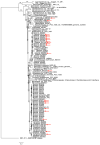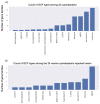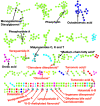A Multi-Omics Characterization of the Natural Product Potential of Tropical Filamentous Marine Cyanobacteria
- PMID: 33418911
- PMCID: PMC7825088
- DOI: 10.3390/md19010020
A Multi-Omics Characterization of the Natural Product Potential of Tropical Filamentous Marine Cyanobacteria
Abstract
Microbial natural products are important for the understanding of microbial interactions, chemical defense and communication, and have also served as an inspirational source for numerous pharmaceutical drugs. Tropical marine cyanobacteria have been highlighted as a great source of new natural products, however, few reports have appeared wherein a multi-omics approach has been used to study their natural products potential (i.e., reports are often focused on an individual natural product and its biosynthesis). This study focuses on describing the natural product genetic potential as well as the expressed natural product molecules in benthic tropical cyanobacteria. We collected from several sites around the world and sequenced the genomes of 24 tropical filamentous marine cyanobacteria. The informatics program antiSMASH was used to annotate the major classes of gene clusters. BiG-SCAPE phylum-wide analysis revealed the most promising strains for natural product discovery among these cyanobacteria. LCMS/MS-based metabolomics highlighted the most abundant molecules and molecular classes among 10 of these marine cyanobacterial samples. We observed that despite many genes encoding for peptidic natural products, peptides were not as abundant as lipids and lipopeptides in the chemical extracts. Our results highlight a number of highly interesting biosynthetic gene clusters for genome mining among these cyanobacterial samples.
Keywords: biosynthetic potential; genomics; marine cyanobacteria; metabolomics; natural products.
Conflict of interest statement
These studies were supported by the University of California, San Diego, Scripps Institution of Oceanography from NIH grant (GM 107550 and GM118815). William Gerwick has an equity interest in NMRFinder and in SirenasMD Inc., companies that may potentially benefit from the research results and also serves on the company’s Scientific Advisory Boards. The terms of this arrangement have been reviewed and approved by the University of California, San Diego in accordance with its conflict of interest policies.
Figures





Similar articles
-
Collection, Culturing, and Genome Analyses of Tropical Marine Filamentous Benthic Cyanobacteria.Methods Enzymol. 2018;604:3-43. doi: 10.1016/bs.mie.2018.02.014. Epub 2018 Apr 27. Methods Enzymol. 2018. PMID: 29779657
-
Exploring cyanobacterial genomes for natural product biosynthesis pathways.Mar Genomics. 2015 Jun;21:1-12. doi: 10.1016/j.margen.2014.11.009. Epub 2014 Dec 5. Mar Genomics. 2015. PMID: 25482899 Review.
-
Comparative Genomics of Cyanobacterial Symbionts Reveals Distinct, Specialized Metabolism in Tropical Dysideidae Sponges.mBio. 2019 May 14;10(3):e00821-19. doi: 10.1128/mBio.00821-19. mBio. 2019. PMID: 31088928 Free PMC article.
-
Comparative genomics uncovers the prolific and distinctive metabolic potential of the cyanobacterial genus Moorea.Proc Natl Acad Sci U S A. 2017 Mar 21;114(12):3198-3203. doi: 10.1073/pnas.1618556114. Epub 2017 Mar 6. Proc Natl Acad Sci U S A. 2017. PMID: 28265051 Free PMC article.
-
Unique marine derived cyanobacterial biosynthetic genes for chemical diversity.Nat Prod Rep. 2016 Feb;33(2):348-64. doi: 10.1039/c5np00097a. Nat Prod Rep. 2016. PMID: 26758451 Review.
Cited by
-
MultiplexMS: A Mass Spectrometry-Based Multiplexing Strategy for Ultra-High-Throughput Analysis of Complex Mixtures.Anal Chem. 2023 Aug 15;95(32):11908-11917. doi: 10.1021/acs.analchem.3c00939. Epub 2023 Aug 2. Anal Chem. 2023. PMID: 37530514 Free PMC article.
-
Advancements in capturing and mining mass spectrometry data are transforming natural products research.Nat Prod Rep. 2021 Nov 17;38(11):2066-2082. doi: 10.1039/d1np00040c. Nat Prod Rep. 2021. PMID: 34612288 Free PMC article. Review.
-
Current Approaches and Implications in Discovery of Novel Bioactive Products from Microbial Sources.Curr Microbiol. 2025 Apr 22;82(6):258. doi: 10.1007/s00284-025-04237-7. Curr Microbiol. 2025. PMID: 40263159 Review.
-
NPOmix: A machine learning classifier to connect mass spectrometry fragmentation data to biosynthetic gene clusters.PNAS Nexus. 2022 Nov 16;1(5):pgac257. doi: 10.1093/pnasnexus/pgac257. eCollection 2022 Nov. PNAS Nexus. 2022. PMID: 36712343 Free PMC article.
-
Fatuamide A, a Hybrid PKS/NRPS Metallophore from a Leptolyngbya sp. Marine Cyanobacterium Collected in American Samoa.J Nat Prod. 2025 Feb 28;88(2):322-335. doi: 10.1021/acs.jnatprod.4c01051. Epub 2025 Jan 29. J Nat Prod. 2025. PMID: 39879528 Free PMC article.
References
-
- Komarek J., Kastovsky J., Mares J., Johansen J.R. Taxonomic classification of cyanoprokaryotes (cyanobacterial genera) 2014, using a polyphasic approach. Preslia. 2014;86:295–335.
-
- Keller L., Leão T., Gerwick W.H. Chemical Biology of Natural Products. Taylor & Francis Group; Oxfordshire, UK: 2017. Chemical Biology of Marine Cyanobacteria; pp. 43–87.
MeSH terms
Substances
Grants and funding
LinkOut - more resources
Full Text Sources
Other Literature Sources

